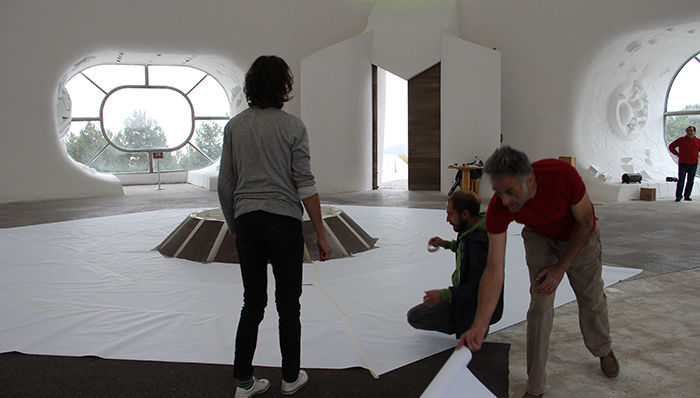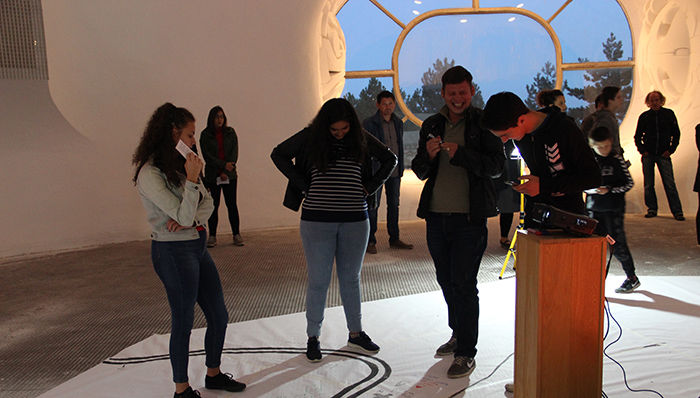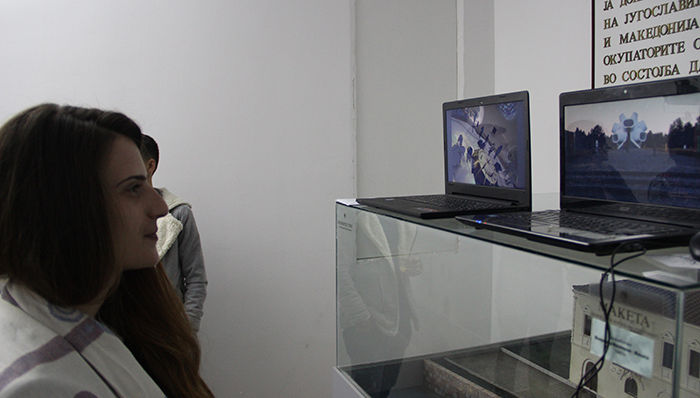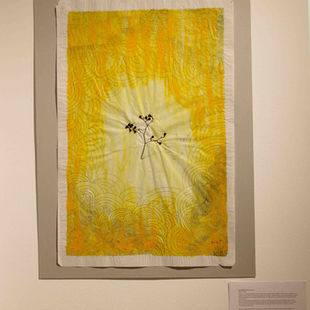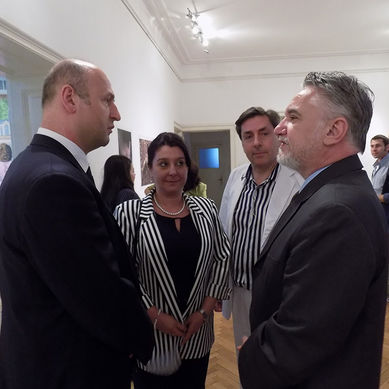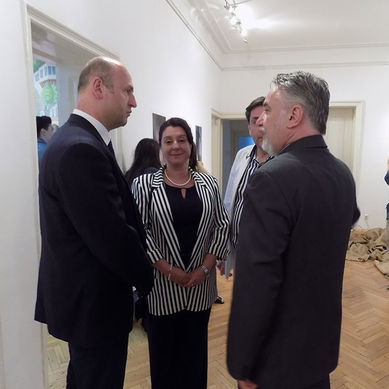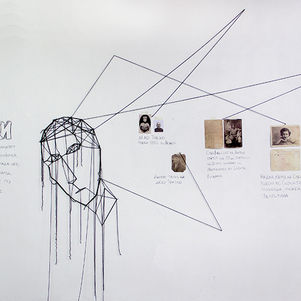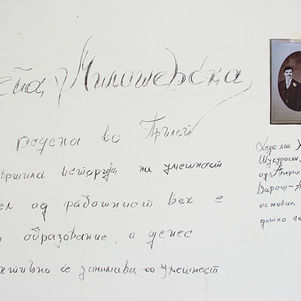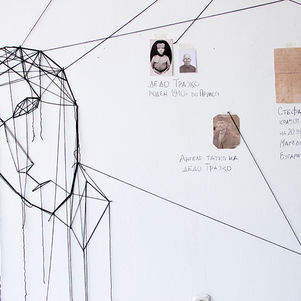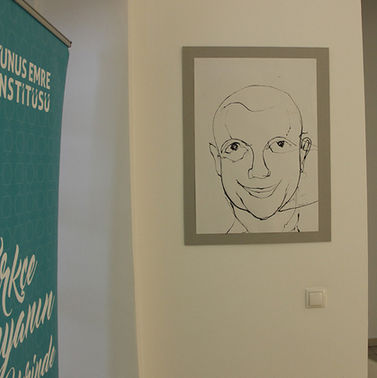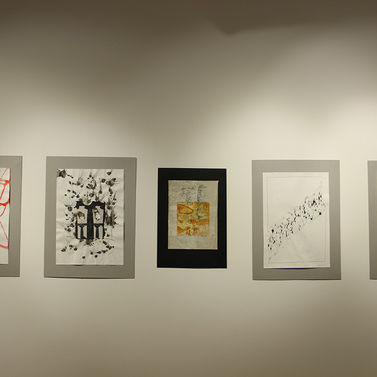
OSTEN BIENNIAL OF DRAWING 2018
Darko Taleski - special award
OSTEN is an INSTITUTION for MUSEUM and GALLERY ACTIVITIES, Skopje, Macedonia has respect for the past, is active in the present and has plans for the future.
A recognized brand in the area of art, emancipated thought, and liberated creation since 1945, with its experience and influence on the improvement of culture and art, over 70 years OSTEN is a successful organizer of international events: the World Gallery of Cartoons(since 1969), Biennial of Drawing & Biennial of Awarded Artists – that attracts the artists worldwide, educate the wider audience and animate art professionals (curators, theorists, critics and art historians) – all which provide an insight and produce materials that document the development and movements of art in our time.
As always, in the foreground is the DRAWING, which marks the beginning of the whole story, while new forms, narrated through various ways of expression and through diverse media, are further developed. The final product is magic and aims to have you bewitched, tap into your inner world without usurping it, but stirring even for a moment your equilibrium with a fresh idea about discovering and enjoying the world around you.
OSTEN – Art on Paper and its main events in the arts – OSTEN Biennial of Drawing &OSTEN Biennial of Awarded Artists symbolize the persistence of OSTEN, which with a strong conviction that art holds the key to positive change in the world, certainly pulls ahead in achieving new accomplishments. For its unique perspective on an important art form – drawing, for its impressive and meaningful collection, all the creative and innovative cooperation initiatives that help to better understand and appreciate artists worldwide, and for establishing a globally recognized voice of the art world from Skopje, Macedonia – OSTEN has become recognizable brand in the world of art. The recognition of OSTEN’s efforts and activities on a global scale are only an additional incentive and confirmation that together with the artists, its distinguished contributors and friends, OSTEN is on the right track and that it grows.
To bring this experience to a wider audience, OSTEN keeps pace with new media and technologies, works and will continue to work towards ensuring the promotion of artists in the international arena by upgrading the already existing digital infrastructure that supports projects Biennial of Drawing and the Biennial of Awarded Artists (osten4art.net). With each new step, every new idea, every new decision, OSTEN is closer to achieving its commitment, overcoming all the obstacles of everyday life and bringing the world artistic expressions to our distinguished audience.
OSTEN BIENNIAL of DRAWING Skopje 2018 was extremely successful by the number of participants (863), the diversity of cultures of the countries that these artists represent (61 countries), and especially by the quality of the submitted works (2317). The enormous interest for participation on the OSTEN BIENNIAL of DRAWING Skopje 2018 demanded a highly professional approach to the process of selection, therefore it went in two stages: selection (by selectors) and judging (by the international jury).
Selector: Luca CURCI, Italy
International Jury:
Manos STEFANIDIS, Greece
Sonja ABADZIEVA, Macedonia
Melanie ZEFFERINO, UK/Italy
The selection process and the jury work distinguished artists/works with the greatest and most original artistic achievements. Here are the results:
OSTEN BIENNIAL of DRAWING Skopje 2018 | AWARDS
MAIN AWARDS
Pierre SOULAGES, France – GRAND PRIX for Lifetime Achievement
Henry MOORE, UK – WORLD CULTURAL HERITAGE Award
Rodoljub ANASTASOV, Macedonia – Special GRAND PRIX for Extraordinary Artistic Achievements
Pasquale CELONA, Italy – Special GRAND PRIX for Contribution in the World Art
JURY AWARDS
Sebastian LUBINSKI, Poland – FIRST AWARD for DRAWING
Olga TOBRELUTS, Russia – FIRST AWARD for PRINT
Barbara KROLL, Germany – FIRST AWARD for PAINTING on PAPER
Petre NIKOLOSKI, UK – FIRST AWARD for ORIGINAL WORK of PAPER
Agnieszka JANKIEWICZ, Poland – FIRST AWARD for YOUNG ARTIST
Darko TALESKI, Macedonia – SPECIAL AWARD by JURY
Herman NOORDERMEER, Netherlands – SPECIAL AWARD by JURY
Anahita YOUNESI, Iran – SPECIAL AWARD by JURY
Dorota KOMAR ZMYSLONY, Poland – SPECIAL RECOGNITION by JURY
AWARDS by WAVA
World Association of Visual Arts
Franco VECCHIET, Italy – ARTIST of the WORLD
Tijana KOJIC, Serbia – YOUNG BALKAN ARTIST
Trayana PANAYOTOVA, Bulgaria – YOUNG BALKAN ARTIST
Christina TZANI, Greece – YOUNG BALKAN ARTIST
OSTEN AWARDS
Eva FRANCOVA, Czechia – GOLDEN OSTEN AWARD
Ninna ANSARI, Germany – GOLDEN OSTEN AWARD
Svetla RADULOVA, Bulgaria – GOLDEN OSTEN AWARD
Suzana MARTIN VILARUBIA, Spain – GOLDEN OSTEN AWARD
Ahmet ALBAYRAK, Turkey – GOLDEN OSTEN AWARD
Bosuk LEE, S. Korea – OSTEN AWARD
Milan ANDOV, Macedonia – OSTEN AWARD
Harris KONDOSPHYRIS, Greece – OSTEN AWARD
Angel PANEVSKI, Germany – OSTEN AWARD
Julio GARAY TERRAZAS, Peru – OSTEN AWARD
Nevzat BEJTULI KICA, Macedonia – OSTEN AWARD for LEGACY
Helen SHULKIN, Germany – OSTEN AWARD for INDIVIDUAL PRESENTATION
BULGARIA – OSTEN AWARD for NATIONAL PRESENTATION


KRUSHEVO MAPING
An Art Exhibition - Monument Ilinden MAKEDONIUM - Krushevo and Memorial Museum "11th of October" - Prilep, Macedonia
6 - 12 October 2018
Subjective mapping is the creation of maps that depict the more personal perception or perspective of the places / space around us through different experiences and experiences of each individual. Unlike the objective description and presentation of the reality that we have been accustomed to scroll daily on the geographical, historical (...) maps. Subjective mapping is an attempt to tell us the stories of a home, a street games, a memories, preserved in objects, words, architecture, parks, in order to re-actualize some of the forgotten stories about the city of Krushevo.
By using the visual language and by exploring the stories of the inhabitants of the city of Krushevo, the three artists Darko Taleski, Emil Soleski and Jasmina Runevska mapped different segments of the space. Through different techniques, they created (non) visual maps of sounds, smells, feelings, stories, memories.Through the participation of twenty youth from Krushevo, a joint subjective map was created, where they draw the most important parts of Krushevo.

The long night of intercultural dialoque
A JOURNEY THROUGH CULTURES
The Long Night Of Intercultural Dialogue is an annual public event that celebrates Vienna’s rich history with culture, creativity and art. This year, it will take place on Saturday, 8. September 2018, offering so much to discover: music, food, art, costumes, insights and discussions, and more.
Austria’s location in the heart of Europe gives it a unique advantage as a melting pot of culture. Various art and cultural venues will extend their opening hours to allow for increased access to the public.
The Long Night of Intercultural Dialogue celebrates this myriad of culture that has shaped the Austrian identity for many years. Visitors will be able to partake in a variety of activities to learn from and experience this diversity that is synonymous to Vienna.
The Yunus Emre Institute will offer visual exhibitions from artist all over the world, letting visitors experience first-hand the varied perspectives our society is built on, as well as get a glimpse of the importance of cultural diversity.

A PART OF ME
An Art Exhibition (photos and short videos as a part of the video performance)
„ YOUR PERCEPTION OF ME IS A REFLECTION OF YOU,
MY REACTION TO YOU IS AN AWARENESS OF ME“
It’s often heart that artists live in their own world, that they are different from the others. But the artist, as everyone else, are part of the societal life and often times their expression is a reflection of the ongoing social changes in the society.
The project is carried out by two artists who live in the Pelagonia region. In this part of Macedonia the tobacco is still one of the main sources of income for many families.
There are many artist from this region in whose works the tobacco has been the main theme.
Ferdi comes from a rural environment, and has been directly involved with the production of the tobacco since he was a child . Darko, on the other hand, coming from a town, has never been directly involved, but is well familiar with the entire process of tobacco cultivation due to the environment. One artist is of Turkish and the other of Macedonian nationality, which further enriches their artwork.
In the project ‘Part of me’ the sackcloth (a rough cloth used when packing the dried out tobacco) is taken to be the main material. The sack cloth carries the smell of the tobacco and it sticks to it in the same way that it sticks to the people who work with it in the fields.
Ferdi uses the sack cloths as his second skin because the skin is, in a way, a memory of life. He faced the hardship brought about by tobacco production when still a child, so the photographs and videos portray that. Pressed between the smell and the weight of the tobacco he is trying to get rid of them. No matter how strong and complete the separation, it leaves marks. That is the reason why in some photographs the’ second skin’ is shown and this time the material is a cling film. It is actually a symbol of the marks the society lives on a person. The difficult conditions, inevitably lead to people trying hard find a way out. They are trying to escape the smell of the tobacco leaves and the firm grip of the sack cloth.
Darko has been experimenting with his skin condition (which he incidentally discovered) for the last 2 years. Demography (or skin painting/ drawing) has become his medium of expression. This is how Darko sees it:
The skin is a covering of the body that both ‘protects us from others and exposes us to them. What I find interesting from the book "Thinking through the skin" by Sarah Ahmed and Jackie Stacey, is a thinking that reflects, not on the body as the lost object of thought, but on inter-embodiment, on the mode of being-with and being-for, where one touches and is touched by others. That how my skin become reflection of my personality.
Often his artwork is related with his attempts to espouse the other people emotions and interpret them in his own way – walk in other peoples’ shoes. The Macedonian proverb for the same would be roughly translated as ‘ to be/live in someone else’s skin’, so in this project the artist does just that: He is using his skin to interpret the other artist emotions, at the same time interweaving his own.

ARE YOU AN MIGRANT TO?
An Art Exhibition - Culture Center "Marko Cepenkov" - Prilep, Macedonia
1 JUNE - 6 JUNE 2018
As a reaction to the world refugee crisis, especially the Syrian refugees who passed through Macedonia on the so called “Balkan Route”, the academic artist Taleski Darko, creates an artwork entitled Help the refugees. In 2015 there was a huge influx of refugees going through Macedonia illegally and since the government offered no help in terms of transport or anything else they were forced to follow the railway tracks late at night. As a result of their lack of knowledge of the terrain many unfortunate accidents happened.
Taleski’s Art, can be freely defined as socially engaged because he reacts to characteristic and unusual situations which define human condition and raises his voice for the less fortunate and helpless people. Wanting to express his revolt because of the hostile environment that surrounds this innocent people, he created his one- minute video, shown in the Contemporary Art Museum in Taiwan (shortened MOCA)
However, the ideas and the concepts that can help the migrants still encourage the artist to create. He tried to capture the extremely complicated issue of MIGRATION, in his exhibition “Are you a migrant too?”
Taleski tries to retell the personal history of several artists from his native Prilep, thus hoping to bring the subject closer to every one of us. His main motive is to awaken and ignite the empathy and compassion of his fellow citizens, who might feel threatened of scared of the refugees and migrants, reminding them via collages of photographs, written testimonies, letters and reports of the lives of our close friends and relatives who were forced or have decided to leave their country willingly.
In remembering the moments spend with is grandfather, the artist Taleski showed interest about the stories of his ancestors. He reacted emotionally at the absence of the people, his close and not so close relatives who had left, while looking at their photos. Those photographs that evoked vivid memories in his grandfather, he used them as a prompt to retell their life stories over and over again, so they are heart and remembered by the child who will remember and pass them on to the next generation. The stories provoked different emotions, images and assumptions in the creative mind of the child. Amongst all the stories the one that left the greatest impression was the one about his grandad’s uncle who had left and moved to Bulgaria. After a while he had sent a photo of his family, his wife and two daughters. One of the daughters, feeling the need to connect and introduce herself to the family she had no chance of meeting or knowing, had sent a photograph of herself as a successful actress in the 30ies.
After the failure of the Civil War in Greece the exodus of ethic Macedonians from Northern Greece begins, taking them to Yugoslavia and other socialist countries. In the changeable and politically uncertain climate of the fifties, begins the life story of the artist Vasko Kostov, born in the Northern Greece. His history is presented on a map where the most important places for the family are marked and highlighted. They too were in search for a better and safer conditions for building a place they would call home. It took Vasko 5 years to get to Prilep. Before he even began his schooling and prior to the beginning of the Civil War his family had left their home in Northern Greece and travelled to Sofia, Bulgaria by train. They were moved and placed in Plovdiv but because of the hostility of the Plovdiv people and his father being sensitive and precocious he moved the family to Lopatica, a village about 50 km from Prilep. Vasko finished first grade there. From there they moved to another village near Bitola. After the end of the World War II, Yugoslavia moved the migrants in Vojvodina, where the German army used to be placed and he finishes second grade there. From there they moved to Tetovo, where Vasko finished 3 grade.
They moved to Negotino in a village for migrants knows as Crveni Bregovi, at the banks of River Vardar. Eventually they moved to Prilep where Vasko finishes 5th grade and his Art teacher advices and guides him towards the realms of Art.
Another wave of migration is also the immigration of the Muslim population from Macedonia and their moving to Turkey in the 1950ies and 1960ises. The life stories of his ancestors are engraved in the memory of the artist Ferdi Bulut, his relatives who left their native village. Yugoslavia signed an agreement with Turkey in 1953 and people left in search of better life. The communism arose then and people’s properties were forcefully taken from them and become the state’s possessions. Some people emigrated because of that too. The inhabitants of the village Kanatlarci sold their entire property and possessions and decided to leave for Istanbul or Izmir travelling from Bitola by train. It was forbidden that the immigrants take gold or money but they were allowed to bring household items. They had to hide some money in home-baked bread or in their clothing. Ferdi’s uncle volunteered to leave the family and try to build a good life. Despite all the hurdles many have succeeded in this.
After Macedonia became officially independent state in 1991 and the transition period began the socio- economical turmoil started and is still ongoing. The disadvantaged situation caused many people to migrate to Western European countries as well as America and Australia. Some moved to stay with relatives but many young highly-skilled and qualified people moved to work and live there (brain – drain process) .
The analysis of modern migration understands the across the border mobility of people: seasonal workers, students, part-time workers, business people, entrepreneurs, members of foreign companies and state firms. The life path of Jasmina Runeska is related to the story of people who left their country once this happened. Her only brother, when only 17, left for America and came to visit once after 10 years. Trying to describe their unique sister-brother connection Jasmina uses different objects from their childhood.
Today, in the era of technical and technological advancement, migrations are an inseparable part of everyday life, especially because of the easy and fast methods of communication and travel. This makes the changes even more evident and dynamic. Trying to find their way, in hope of better social structure and fairer non – nepotistic system, where the workers are respected and acknowledged, the two children of the artist Lepa Milosevska also left their home in Macedonia. In 2010 her son who is a doctor leaves. In 2015 her daughter -an architect- leaves as well. They both move to Germany where they started families and new life. Their interaction and relation are best retold by the photographs that witness their meetings. The parents statements are included as well.
Vikotoria Dimeska
Art Historian

Art and borders
curated by Marilena Streit Bianchi
Many artists are animating Prilep a town in the South of Macedonia North of the ancient Pelagonia known since the antiquity for the pure white marble production between them Darko Taleski and Ferdi Bulut active in participating to exhibitions in Macedonia and abroad.
They do not belong to any defined art movement and both are also art school teachers. The exhibition conceived for the Yunus Emre Institute of Vienna is outlining the line as dominant character, a line that define forms and space and also represent a limitation, a border defining a territory where life is confined to be. A line in quest of the Self and looking at the surrounding world with its marvels and unknown. A line defining borders they want to break to connect to the world and escape the loneliness of being. The thread is never lost like in Darko portraits where he uses the pencil without stopping the line until the figure is completed. Darko once told me “I am very proud of the result I have achieved in my portraits. There is a continuous building of forms and character, I am able to bring to light some of the traits that compose a personality, the incompleteness, the fears.”
Fear is even more evident in some of Ferdi artwork presented here. Ferdi present fragments of his production, fragments of feelings where despair and hope are united, a cry for help a hope for a better future.
The main message the artists have is “we are citizen of the world not simply citizen of our country, diversity is a plus to any society, we should not resign if we want to escape the nothingness.”
Darko has won several competitions at Microsoft Educational Global Forum and participate in international educational projects. “Why I have been putting so much effort into it since years, says Darko, It is because I love art, I love education and I believe that equal opportunity should not remain a slogan, a a void word and children of remote villages of my country have the right to have the same opportunity of learning as if they were in a big town to become the citizen of tomorrow society perhaps in Macedonia, perhaps somewhere else.”




LINE
In Darko Taleski art work the lines are cut wounds, the expression of the breaking of the self, and borders that shall be broken to overcome the isolation.
Artist has a social role and this is what Darko is highlighting with his artistic and teacher work.
(Marilena Streit-Bianchi, exhibition curator)

